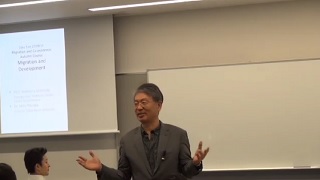| 教員/講師名 | 浦元 義照 |
|---|---|
| 開催年度 | 2017年度 |
| 開催日 | 秋学期 |
The UN defines an international migrant a person who stays outside their usual country of residence for at least one year. The world stock of international migrants is estimated 243 million (or 3.3 % of the world population) in 2015 (UN DESA). With modern internet communication, mass media and mobile phone, international migration became easier than ever. it is no longer kept secret that many parts of the world are faced with lack of employment opportunities, growing population, political crisis, armed conflicts, poor economy, and inadequacy of social services and that many advanced countries offer better lives and opportunities for gainful employment. Informal networks of migrant workers and diaspora would add an useful and credible source of information that could greatly facilitate the migration. Economic benefits of migration through remittances add great value to migration. In 2015, according to the World Bank, the total remittances in the world amounted to at least US$600 billion, enough to boost demand and GDP in sending countries. They are almost 4 times the value of total ODA and charities. Actual amount of remittances are considered to be double the official figure. Many of those crossing borders,, however, fell into the hands of increasingly sophisticated people-trafficking gangs and are not receiving services and protection as expected. The large share of female migrants is a significant characteristic of the current migration. They often work as health care providers, domestic workers and sex workers. The human migration is critical global issues that affect people. How could labour migration be effectively managed for further development of the world economy? What regulatory framework should be developed in order to protect them from abuse? How could the social protection measures be extended for those migrant labourers? What can the governments, civil society, non-government organisations, and international organisations do to protect them? What are the policy options? Throughout the interdisciplinary course on Migration and Development, causes and consequences of migration will be the crosscutting themes. Specific subjects of the course include: (1) dimensions and dynamics of international migration, (2) Causes and consequences of labour migration in sending countries, (3) Theories of migration, (4) Migration policies of destination countries, (5) Skills, undocumented migration and protection of migrants, (5) Brain drain, remittances and development, (6) Role of state in quest for control , and (7) future of international migration. In order to ensure a quality learning environment, TOEFL 550, TOEFL IBT 79, TOEFL ITP 550, IELTS 6.0 or the equivalent English skills are preferred.This does not apply to FLA, Green Science and Green Engineering students as well as exchange students from universities that use English as the language of instruction.
Before each session reading materials wil be uploaded in the Moodle. The materials are extracts from the reference books. This includes (1) "ASEAN Community 2015: Managing integration for better jobs and shared prosperity", ILO Regional Office for Asia and Pacific and Asian Development Bank (ADB), 2014 and (2) Migration and Development: A Theoretical Perspective. International Migration Review. 44(1), pp. 227-264 Hein De Haas, 2010
著者名/Authors:Stephen Castles, De Haas, Hein & Mark J. Miller
著者名/Authors:Khalid Koser
著者名/Authors:Russell King et al |
|
